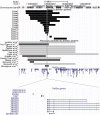A novel microdeletion syndrome at 3q13.31 characterised by developmental delay, postnatal overgrowth, hypoplastic male genitals, and characteristic facial features
- PMID: 22180640
- PMCID: PMC3261728
- DOI: 10.1136/jmedgenet-2011-100534
A novel microdeletion syndrome at 3q13.31 characterised by developmental delay, postnatal overgrowth, hypoplastic male genitals, and characteristic facial features
Abstract
Background: Congenital deletions affecting 3q11q23 have rarely been reported and only five cases have been molecularly characterised. Genotype-phenotype correlation has been hampered by the variable sizes and breakpoints of the deletions. In this study, 14 novel patients with deletions in 3q11q23 were investigated and compared with 13 previously reported patients.
Methods: Clinical data were collected from 14 novel patients that had been investigated by high resolution microarray techniques. Molecular investigation and updated clinical information of one cytogenetically previously reported patient were also included.
Results: The molecular investigation identified deletions in the region 3q12.3q21.3 with different boundaries and variable sizes. The smallest studied deletion was 580 kb, located in 3q13.31. Genotype-phenotype comparison in 24 patients sharing this shortest region of overlapping deletion revealed several common major characteristics including significant developmental delay, muscular hypotonia, a high arched palate, and recognisable facial features including a short philtrum and protruding lips. Abnormal genitalia were found in the majority of males, several having micropenis. Finally, a postnatal growth pattern above the mean was apparent. The 580 kb deleted region includes five RefSeq genes and two of them are strong candidate genes for the developmental delay: DRD3 and ZBTB20.
Conclusion: A newly recognised 3q13.31 microdeletion syndrome is delineated which is of diagnostic and prognostic value. Furthermore, two genes are suggested to be responsible for the main phenotype.
Conflict of interest statement
Figures


References
-
- Fujita H, Meng J, Kawamura M, Tozuka N, Ishii F, Tanaka N. Boy with a chromosome del (3)(q12q23) and blepharophimosis syndrome. Am J Med Genet 1992;44:434–6 - PubMed
-
- Genuardi M, Calvieri F, Tozzi C, Coslovi R, Neri G. A new case of interstitial deletion of chromosome 3q, del(3q)(q13.12q21.3), with agenesis of the corpus callosum. Clin Dysmorphol 1994;3:292–6 - PubMed
-
- Jenkins MB, Stang HJ, Davis E, Boyd L. Deletion of the proximal long arm of chromosome 3 in an infant with features of Turner syndrome. Ann Genet 1985;28:42–4 - PubMed
-
- Lawson-Yuen A, Berend SA, Soul JS, Irons M. Patient with novel interstitial deletion of chromosome 3q13.1q13.3 and agenesis of the corpus callosum. Clin Dysmorphol 2006;15:217–20 - PubMed
-
- Mackie Ogilvie C, Rooney SC, Hodgson SV, Berry AC. Deletion of chromosome 3q proximal region gives rise to a variable phenotype. Clin Genet 1998;53:220–2 - PubMed
Publication types
MeSH terms
Substances
Grants and funding
LinkOut - more resources
Full Text Sources
Other Literature Sources
Medical
